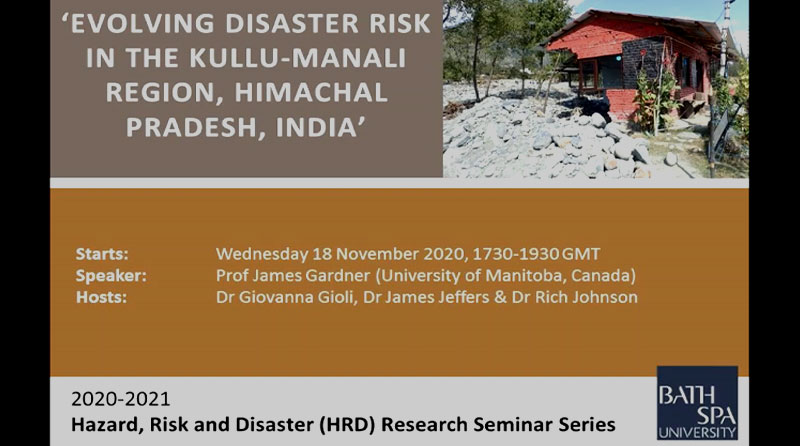Evolving disaster risk
Event
Evolving disaster risk in the Kullu-Manali region, Himachal Pradesh, India.
Wednesday 18 November, 2020 – Wednesday 18 November, 20205:30 PM – 7:30 PM
Online
Part of the Hazard, Risk and Disaster (HRD) Research Seminar Series 2020-21.
The Kullu-Manali region in the northwest Himalaya of India provides an example of rapid population growth, economic development and social change that has characterised many high mountain areas in the late twentieth and early twenty-first centuries.
The evolution of disaster risk is described in this context, though conditions from a more distant past may have set the process in motion.
The Kullu-Manali region has been settled in various forms, including well-established villages and transport routes, for at least a millennium. It has been and is exposed to a variety of environmental hazards that pose a risk to people, property and infrastructure. The hazards have manifest across a range of scales from local, site-specific slope failures and debris torrents, for example, to watershed-scale floods, regional-scale earthquakes and pandemics, which are global-scale by definition.
In the Kullu-Manali region, key factors in this evolutionary tale include: pre-colonial settlement patterns and activities; renewed settlement and codification of land use rights in the colonial period; recodification and land redistribution following Indian independence; and neighboring conflict, agricultural/horticultural innovation and growth of domestic tourism from 1990 to the present.
Such factors have acted as triggers in a stepwise escalation of disaster risk. For example, a regional earthquake of the magnitude of the 1905 Kangra event, that had disastrous impacts in the area, would produce consequences orders of magnitude greater in absolute terms under present circumstances. Though climate variability and change, and that in related bio-geophysical conditions, may have contributed to hazardousness, the escalation of disaster risk has been driven by social, economic, political, etc. change across scales from the local to global. Whether resilience in the face of disaster has grown proportionately remains an open question.
About the speaker
James Gardner is Emeritus Professor at the Natural Resources Institute of the University of Manitoba in Winnipeg, Canada. He lives in Victoria, British Columbia from where he continues with some research, writing and student supervision. Over a lengthy career as a teacher, researcher and administrator, his interests have focused on geomorphological, glaciological and hydrological processes and related resource and hazard management implications, particularly in high mountain environments. Of relevance to this presentation are 35 years of research in and about the Himalaya and Trans-Himalaya from northern Pakistan through India and Nepal to southwest China. When first teaching about natural hazards in 1970, his focus was on the understanding of physical processes but over time it became evident that emergent accidents and disasters are at least equally constructed by conditions in the communities and societies involved. Thus, much of his more recent research and writing has been done in collaboration with colleagues with social science expertise.
Recent publications:
- Gardner, James (2020). How water, wind, waves and ice shape landscapes and landforms: Historical contributions to geomorphic science. Geomorphology, 366, 1 Oct, doi.org/10.1016/j.geomorph.2019.02.031.
- Johnson, R.M., Edwards, E., Gardner, James S. and Diduck, A.P. (2018). Community vulnerability and resilience in disaster risk reduction: an example from Phojal Nalla, Himachal Pradesh, India. Regional Environmental Change, doi.org/10.1007/s10113-018-1326-6.
